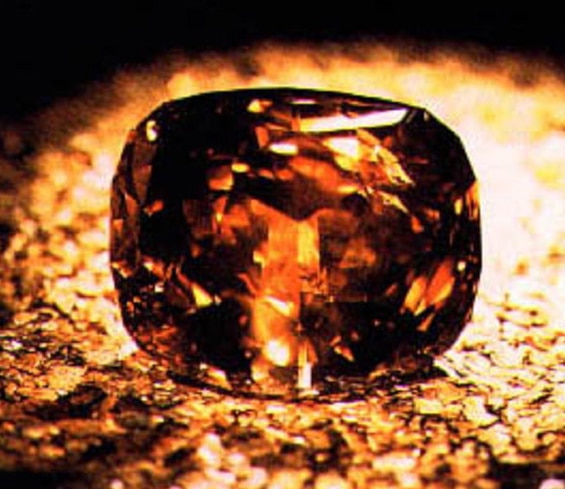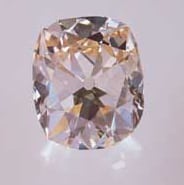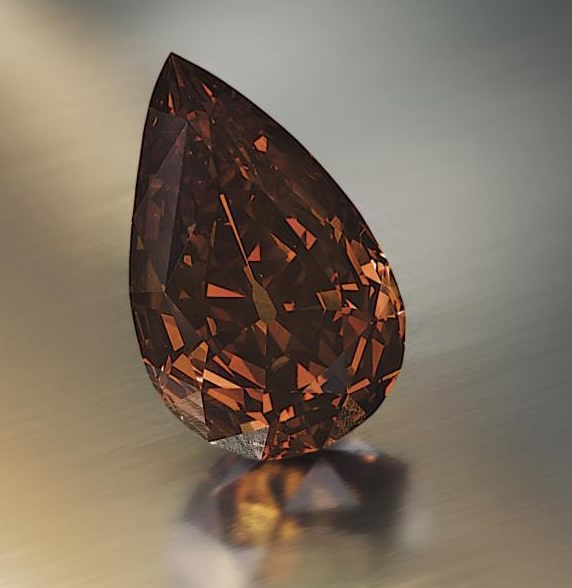Home » Fancy Colored Diamonds » Brown Fancy Colors
Focus on
The largest polished diamond in the world weighs 545.67 carats, which is 15.37 carats larger than the Cullinan I, the largest diamond in the British Crown Jewels, which had held the title until 1987. But visually, what really sets the two apart is that, whereas the Cullinan is white or colorless stone, the Golden Jubilee is a fancy yellow brown diamond.
Interestingly, the Golden Jubilee was discovered as a 755.5-carat rough stone at the same location as the Cullinan, the famed Premier Mine in South Africa, which was the source of several other famous gems, such as the Taylor-Burton Diamond. Because of a number of prominent inclusions and deep cracks in the rough stone, the mine’s owner at the time, De Beers, employed the services of the world’s most respected cutter of large stones, Gabi Tolkowsky, to oversee the manufacturing process.
In the 1980s, a brown diamond ordinarily would not have warranted such attention, but the stone provided Tolkowsky with the opportunity to test tools he was developing to cut the Centenary Diamond, a 273.9-carat white stone that was the third-largest polished diamond to have been sourced from rough discovered at the Premier Mine and named in honor of the Centennial Celebration of De Beers in 1988.
To optimize the beauty of the brown stone, Tolkowsky created what he called the fire rose cushion cut. He reportedly set up an underground chamber that would be free of vibrations, which could adversely affect the process. It took two years to complete the job, but the results were spectacular.
Still, the massive stone went unsold for eight years, and during that period it was known simply as the “Unnamed Brown.” But in 1995, it was purchased by a Thai consortium, who before bringing it home took it to the Vatican, where it was blessed by Pope John Paul II
The diamond was then presented to the Thai monarch, King Bhumibol Adulyadej, and its name was changed to the “Golden Jubilee Diamond,” in honor of his 50 years on the throne. Today it can be found in the Royal Palace in Bangkok, where it is part of the Thai Crown Jewels.
Among second-century Romans, brown diamonds were popularly set in rings, but they then fell out of favor and for more than 1800 years were considered worthy mainly of industrial use. What changed their fortunes was the opening of the massive Argyle mine in Western Australia in 1985, where a major part of production was made up of brownish and brown stones.
To popularize fancy brown diamonds, Argyle’s owner, Rio Tinto, began a massive marketing campaign, in which they referred to them by a variety of more attractive and frequently appetizing names, such as “cognac,” “champagne” and “chocolate.”
The colors in natural brown diamonds are the result of internal parallel brown grain lines, which are caused by distortions of the crystal lattice. They range in tone from very light to very dark, with the most popular varieties being medium to dark tones with a warm, golden or reddish appearance. Often, greenish, yellowish, orangey, or reddish modifying colors are present as well.
At the Gemological Institute of America (GIA), brown diamonds are graded against a special set of master stones. Faint to light brown diamonds fall within the standard K to Z color range, but brown diamonds outside of the D-to-Z scale will receive fancy light brown, fancy brown or fancy dark brown grades, depending on their tone.
A number of brown diamonds other than the Golden Jubilee have achieved international fame. Among them is the 128.9-carat Star of the South, which has a slightly pinkish hue. Also known as Estrela do Sul, it was discovered in Brazil in July 1853. It was cut into a cushion shape and has a clarity of VS2.
The Kimberley Diamond was discovered between 1869 and 1871 as 490-carat, champagne-colored rough diamond crystal, and found its way as a large, flat stone into the Russian Crown Jewels. In 1921 it was cut in the United States as a flawless, 70-carat, step-cut, diamond, and in 1958 in was recut into a more modern emerald-cut form, weighing 55.1 carats.
Believed to be South African in origin, the 65.57-carat Golden Maharaja diamond is modified pear-shape, graded by GIA as fancy dark orange-brown with VS2 clarity. It was first exhibited at the Paris World Fair in 1937, and from 1975 to 1990 was on display at the American Museum of Natural History in New York City.
MID House of Diamonds is of the world’s preeminent suppliers of loose fancy-colored diamonds, with a large and varied stock that includes brown stones. Because it is a world of which many diamond buyers are less familiar, with different pricing patterns and grading standards, MID invites you to speak with one of the fancy color experts on its team.

The world’s largest polished diamond, the 545.67-carat Golden Jubilee, a fancy yellow brown fire rose cushion cut stone that is today part of the Thai Crown Jewels.

The 128.9-carat Star of the South, which is light brown with a slightly pinkish hue. Also known as Estrela do Sul, it was discovered in Brazil in July 1853.

The 65.57-carat Golden Maharaja diamond, a modified pear-shape stone that was graded by GIA as fancy dark orange-brown with VS2 clarity.
Other Fancy Colors
